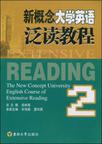新概念大学英语泛读教程
出版时间:2008-12 出版社:东南大学出版社 作者:戎林海 主编,许伟燕,夏玲英 分册主编 页数:176
前言
弗朗西斯·培根曾在他那著名的《论读书》一文中指出:读书使人充实(reading makes a full man),中国也有二句古谚:一为:“书读百遍,其义自现”。二为:“熟读唐诗三百首,不会作诗也会吟。”培根强调的是“读书”(阅读)与人生,而后二者强调的是“阅读”与“理解”、与“写作”(创作)的关系。不论怎样三者都突出强调了“读书”(阅读)的功用。“读书”就其本质而论就是“阅读”,而“阅读”又可分为“精读”(intensive reading)、“泛读”(extensive reading)、“跳读”(skipping)、“扫读”(scanning)和“快速阅读”(fast reading)以及“朗读”(reciting),也就是培根先生所说的some books are to be tasted,Others to be swallowed,and some few to be chewed and digested。 学习一门外语,既需要“精读”也需要“泛读”,在某种意义上讲,“泛读”的多少决定了外语学习的成败高低。顾名思义,“泛读”就是泛泛而读,它的目标是通过大量的阅读,拓宽视野,扩大知识面,增加词汇量,从而增强语感——而语感是学习外语最最重要的一个因素。
内容概要
本套教程取名为新概念,主要反映在以下几个编写特点: 阅读材料丰富多样,题材广泛,体裁多样,内容新颖,注重知识性、趣味性与实用性; 突破传统教材课文篇幅太短的局限,阅读量明显加大; 注重培养学生快速、准确、有效地获取信息的能力; 增加了有关中国传统节假日方面知识的阅读与摄取,以增强学生跨文化交际的能力; 为增强实用性,本教程有目的地收录了一些实用类体裁的阅读材料:如广告、信函、合同、协议、招标书以及招聘启事等,以便学生通过阅读和初步接触能了解此类文章的格式及其用词。 《新概念大学英语泛读教程》一套四册。每册有15个单元,每个单元由三部分组成:阅读课文和练习、快速阅读和练习、课外阅读和练习。此外,为方便阅读,我们在阅读课文和课外阅读后面增加了部分必需的注释。每册书后都配有练习参考答案,以便利教师和学生的教与学。 《新概念大学英语泛读教程》(1-4册)由常州工学院外国语学院院长戎林海教授担任总主编,负责全书的策划、选题、编写体例设计、全书书稿的三审和终审。1-4册每册设有两个主编,负责本册的编写与初审。 本套教材在编写与出版过程中得到了学校领导李文虎教授、教务处朱锡芳处长以及东南大学出版社刘坚博士的关心与支持,值此出版之际,谨向他们表示衷心的感谢。由于编者的水平和经验有限,全书错误和缺点在所难免,敬请读者批评指正。
书籍目录
Unit One Part One Text Americans are Queer Part Two Fast Reading Chinese Culture Broadens Its World Influence Part Three Supplementary Reading Language BarriersUnit Two Part One Text April Fool's Day Part Two Fast Reading The Thanksgiving Story Part Three Supplementary Reading Dates and OriginsUnit Three Part One Text Miracle at Niagara Part Two Fast Reading You Don't Have to Be Perfect Part Three Supplementary Reading Perils of ProhibitionUnit Four Part One Text School Costs Are Rising in Britain, Too Part Two Fast Reading Factory Life--A Student's Experience Part Three Supplementary Reading (1) Budget Puts Students in More Debt (2) PosterUnit Five Part One Text Let Your Mind Wander Part Two Fast Reading How to Motivate People to Work? Part Three Supplementary Reading Ways to Get a Happy State of MindUnit Six Part One Text An Ancient Food in Modem Forms--Milk Part Two Fast Reading Salt Part Three Supplementary Reading The Bird Flu: How Much Fear Is Healthy?Unit Seven Part One Text Benjamin Franklin Part Two Fast Reading Alfred Nobel--a Man of Contrasts Part Three Supplementary Reading Better Known as Mark TwainUnit EightUnit NineUnit TenUnit ElevenUnit TwelveUnit ThirteenUnit FourteenUNit Fifteen
章节摘录
The hardest-and most personal-sermon I ever gave in 30 years as a rabbi was on Yom Kippur, one year after our son had died at age 14. Its on this Jewish Day of Atonement that we atone, or make our split, imperfect selves at one. I knew my sermon would have to be a major statement about what losing a son had meant to me and to my faith, and how I could go on believing in a world where young children died. I took my text from a little book called The Missing Piece, which I can describe only as a fairy tale for adults. It tells the story of a circle that was missing a piece. A large triangular wedge had been cut out of it. The circle wanted to be whole with nothing missing, so-it went around looking for its missing piece. But because it was incomplete and therefore could roll only very slowly, it enjoyed the sunshine. It found lots of different pieces, but none of them fit. So it left them all by the side of the road and kept on searching. Then one day the circle found a piece that fit perfectly. It was so happy. Now it could be whole, with nothing missing. It incorporated the missing piece into itself and began to roll. Now that it was a perfect circle, it could roll very fast, too fast to notice the flowers or talk to the worms. When it realized how different the world seemed when it rolled so quickly, it stopped, left its found piece by the side of the road and rolled slowly away.
图书封面
评论、评分、阅读与下载
用户评论 (总计1条)
- 物流有点小慢 书是不错的
